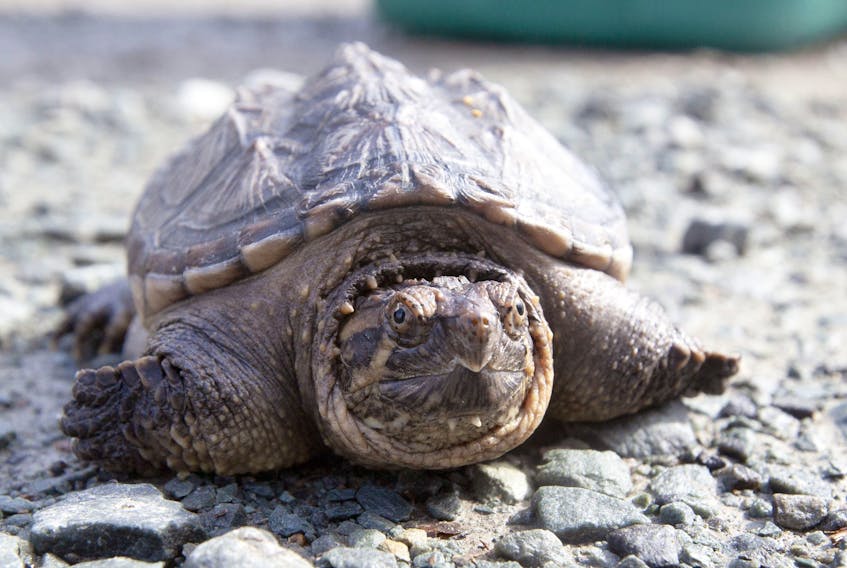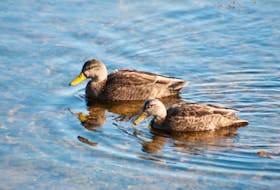Red tape may spell doom for some snapping turtle eggs in nests along Cobequid Road.
Clarence Stevens of the Turtle Patrol, a volunteer group aiming to help ensure the survival of species in the wild, said the three nests at two different sites along the road were accidentally covered during construction on road shoulders.
Two nests are beneath compacted gravel while a third has been covered with rocks he described as the size of a human head.
The group wants to remove the big rocks in the hopes that the baby turtles might be able to get out but Stevens says Nova Scotia’s Lands and Forestry department won’t let them do it.
Bruce Nunn, spokesman for Lands and Forestry, said that because the snapping turtles have been designated a species at risk both provincially and federally, any interaction at all with the animals requires a permit and the Turtle Patrol has not applied for one for that site.
They have applied for permits for other activities.
“Currently, the department is working with this group to complete an application for a permit to count egg shells after nests hatch and to place hatchling turtles found under particular conditions in aquatic habitats,” Nunn said in an emailed statement. “For that permit application to be completed, we are awaiting further information from the Turtle Patrol group.”
Bob Bancroft, president of Nature Nova Scotia and wildlife biologist, said snapping turtles are interesting animals.
“They’re a long-lived species,” Bancroft said. “They live for at least half a century and more.”
Unfortunately, their choice of nesting sites are often affected by humans.
“They tend to lay their eggs in open gravel areas, like a lot of turtles, in the early summer or late spring and the eggs tend to hatch in the fall,” Bancroft said. “Although if we have a really cool summer, sometimes they may overwinter and then hatch in the spring.”
Given the hot summer the region has experienced, the eggs should have already hatched, he said, and if they’re covered, they may not be able to dig out.
The eggs under the larger stones may already be crushed, Stevens fears.
The Turtle Patrol volunteers would be happy to remove the big rocks themselves but they aren’t permitted to do so. Stevens said the contractor and the city of Halifax are both agreeable but it’s up to Lands and Forestry.
The group, now in its third year of trying to help snapping turtle nest sites, was able to do similar work in the spring and rescued some eggs from a nest buried by construction.
Stevens also said that as recently as last weekend, at other nest sites in the province, they were moving hatchlings off roads
and scaring crows away so the turtles wouldn’t be eaten. Then they were contacted by Lands and Forestry and told to stop.
“It’s mind-boggling to us that Lands and Forestry, the department that is supposed to be protecting this endangered species, supposed to be carrying out the work, won’t send any of their people to do it and they’re stopping volunteers that want to put in their own time and effort to help these turtles. They’re preventing them from doing it, as well.”
Meanwhile, the group is checking every day to see if the nests under the smaller, compacted gravel will produce hatchlings, although they are overdue.
“If they don’t come out by the end of the month, then it means that they’re lost,” he said.
Until permits come through for the group to help hatchlings, though, even if the turtles do break through the gravel, the volunteers aren’t authorized to take any action at all.
“At this point, if we have babies out on the road, we’re not even allowed to pick them off the road. We have to let them be run over by traffic.”
Nunn said in his email anyone who comes across a nest is asked to not disturb it and to contact the local office of Lands and Forestry.
“All research or conservation activities need to be carefully evaluated and conducted under a permit that meets the specifications of the Endangered Species Act and the Wildlife Act,” the email said.
To the Turtle Patrol, it seems like there’s little interest in helping with these nests, Stevens said, adding that by the time the four- to six-week time frame passes for the permit application to be processed it will be too late.
“Now we’re basically taking on the role of observer,” Stevens said. “Now we’re just recording babies being killed, basically. So that’s a pretty sad state to go from being able to save babies to just watching them die.”









